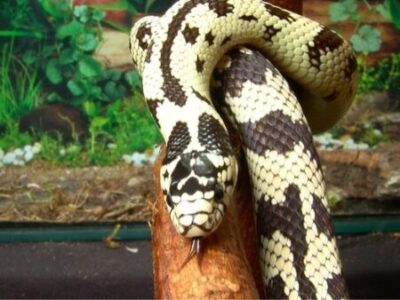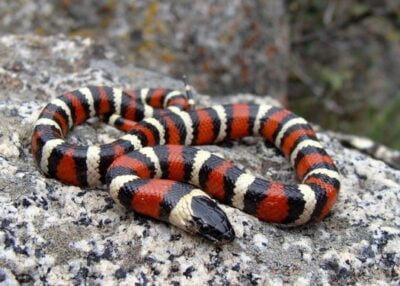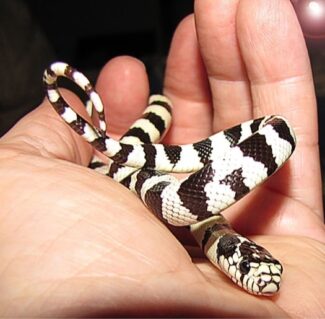Lampropeltis getula californiae — the California kingsnake — makes a good beginner pet. They’re one of the most commonly-owned species of constrictor snakes and are well-liked for their friendly temperament. They’re also easy to look after and remain a manageable size throughout their lifespan. Caring for a California kingsnake is relatively easy.
When in captivity, California kingsnakes enjoy a diet of rodents and are easily adaptable to their surroundings. Best suited to glass or plastic vivariums, they rarely get aggressive and when handled correctly, are happy to be held for short periods of time. Aspen shavings, Orchid bark, coconut husk or ReptiBark make great substrate (bedding) for your snake to burrow in. And being from warmer climates, heat lamps should be used to provide the right level of heat.
To find out more about each one of these points in greater detail, we’ve got some important care tips and advice for providing a happy, stress-free home for your California kingsnake.
How to Care for a California Kingsnake
The Rosamond Gifford Zoo describes the California kingsnake as having shiny black scales with bright white markings. Most California kingsnakes have white bands, but some populations have longitudinal stripes going from their heads to their tails.
California kingsnakes are about 8-12 inches once hatched. On average, they grow to about 3 – 3 ½ feet. 4 feet is about the longest the snake will grow to.
The length and size of your snake really depend on how well they are fed during the early stages of their life. By feeding your snake more than you should, it will get longer instead of fatter.
While California kingsnakes are easy to care for, there are some key things you need before your pet arrives. You’ll need the following for your snake:
- An enclosure (plastic)
- A heat lamp or heat mat
- A substrate
- A water bowl
- A spray bottle
- A thermometer and hygrometer
- ‘Furniture’ climbing apparatus
- Disinfectant for cleaning the enclosure
- Real or fake plants (optional)
- Handling tongs (optional)
- A background (optional)
While this may seem like a lot of equipment, everything on the list is an important piece of kit to ensure your snake lives a comfortable, enjoyable, stress-free life. In total, expect to pay upwards of $350.

Types of Enclosure
When it comes to the enclosure for your California kingsnake, you have plenty of choices. Your preference will likely come down to the overall look, price, and security of the vivarium. These are the different types of enclosure available for your California kingsnake:
- Glass vivariums. These are some of the most popular enclosures available for your snake. One of the benefits is that because there are four glass walls, you can see through it at every angle. This makes it easy to track your snake’s whereabouts. We should note that glass vivariums can be difficult to heat.
- Plastic enclosures. Plastic cages encompass many different types. They can be basic storage bins, or small boxes ideal for hatchlings. They’re a cheap option if you’re on a budget and they also retain heat and moisture much more efficiently than a glass vivarium.
- Racks. Racks are mostly suited to breeders and expert snake handlers. They can help breeders house multiple snakes at once, comfortably.
Consider the conditions you live in. For example, if you live in a house that needs constant air conditioning, you should think about choosing a glass enclosure that retains humidity and moisture otherwise the cage will become too cool. Keep your cage clipped/locked so your snake escape.
Tank Size Requirements
Getting the size of your enclosure right is very important for your snake’s health and wellbeing. While you don’t want something too small, you don’t want something that’s too big either. This is because your snake could get nervous about the extra space available to it.
Your snake should be able to stretch out inside their enclosure. Also, allow at least a third of the snake’s length for the width and height so that it has a bit of added space to enjoy.
As a hatchling, your California kingsnake can begin its life in an enclosure as small as 10 gallons. From a year old, you can begin to increase the size to something more comfortable. Yearlings can be put in enclosures measuring 30” x 12”, while adults are well suited to tanks measuring at least 36” x 18”.
Another important thing to remember is that your vivarium must be secure to prevent any chance of escape and to keep snakes away from hazards. It’s also essential that your vivarium has good ventilation to stop the build-up of harmful bacteria. Keep it away from radiators or any other sources of draught and heat.
Lighting And Temperature
As California kingsnakes originate from the west coast, they prefer their environment to be fairly warm. It’s important to keep them somewhere to cool off if they want to, however. Snakes are dependent on external thermoregulation to control their body temperature, so you should provide both a cool and hot side to your enclosure.
For the hot side, heat it to 88 – 90 degrees and add a hide so your snake can curl up and bask in the warmth. Place another hideaway on the cool side and make sure it reaches temperatures of 75 – 80 degrees. At night, you can let the temperature drop down to 72 – 75 degrees.
To achieve these temperatures, heat pads are the safest and easiest pieces of equipment to use. You should also place at least two thermometers in their enclosure to measure both the ambient air temperature and the warmth in their basking zone. It’s really important you don’t guess the temperatures as you probably won’t get them right. Effective heating options include:
- Heat lamps. You can choose from either an incandescent or red light heat lamp, which you place on the top of the vivarium. This is so that the heat shines right down into it.
- Ceramic heating elements. While similar to a heat lamp, you use one of these instead of screwing a lightbulb into a reflective hood. You’ll get heat but no light with this option.
- Under-tank heat pads. This option offers heat rising up from the ground, as you place the adhesive pads to the underside of the cage. You then plug it in to achieve the heat.
- Under-tank heat tape. This is basically the same as pads, but you use strips of tape instead.
When it comes to the lighting requirements, California kingsnakes (like all reptiles) use natural daylight to set their day and night patterns. Sunlight contains UV (ultraviolet), which is where UVB can be found. This allows reptiles to make vitamin D3 so that they can absorb essential dietary calcium.
UVA is also in UV, which is essential for your snake’s vision. Using a full-spectrum fluorescent light (one that produces both UVA and UVB rays) will give your snake about 10 hours of light each day. Set the timer using the natural rise and fall of the sun as your guide. Replicating natural conditions for your snake will benefit the snake’s overall health.
Humidity Requirements
California kingsnakes are very adaptable when it comes to the humidity of their enclosure. Depending on whether they’re native to dry regions like the desert, or more humid regions like the coast or forest areas, you can set the humidity to between 30% and 60%. Go for a lower humidity for dryer areas and higher for wetter regions.

You might be wondering how to set the humidity, but this is actually a fairly easy job. You simply need a spray bottle, water bowl, and hygrometer – a device used to measure the humidity. Spraying once a day is normally enough to maintain the correct humidity levels, but you’ll need to keep an eye on them and adjust the amount you spray accordingly.
Also, try creating a moist hideaway for your snake by filling it with damp sphagnum moss or paper towels.
Shedding
California kingsnakes will shed their skin every 2-3 months. Perhaps more frequently when they’re young and growing. Your snake’s scales will turn a full opaque color and their eyes will turn cloudy.
To help your snake shed its skin, lay a damp towel inside the cage in a shape that allows it to slither through. This will help lubricate the skin so that it comes off easily. Don’t handle or feed your snake during the shedding process, as this will stress your pet out and make them aggressive.
Substrate (Bedding)
The substrate is an underlying substance or layer used to layer your snake’s enclosure. California kingsnakes like to burrow. In the wild, they’ll usually find unused rodent burrows to manage their temperature levels, so it’s a really good idea to emulate this experience in your enclosure.
There are many types of substrate and bedding available for your snake. Here are some of the best substrates available to use:
- Orchid bark, coconut husk or ReptiBark. These materials are great for burrowing and are ideal for California kingsnakes. They’re like wood chip and are all fairly affordable options.
- Aspen shavings. These are tree shavings and allow the snakes to burrow while holding their shape.
Whichever substrate you choose to use, you’ll need to replace all the material from the vivarium at least once a month so that it’s fresh, clean and healthy.
Substrates To Avoid
Never use sand as a substrate. You can’t clean it but it can also be ingested by your snake as well as becoming stuck under their scales.
Unlike Aspen shavings, cedar shavings are not good for your snake’s health. The oils found within them are generally thought to have a harmful effect on snakes over time, which isn’t worth the risk.
Water And Soaking
If California kingsnakes aren’t getting enough moisture from their enclosure, they’ll bathe in their water bowl. Snakes will do this naturally — just make sure the bowl isn’t too deep so that they can easily get in and out of it. Aiming for a water bowl that allows your pet to sit completely underneath is perfect.
Snakes may need a little help with bathing if they can’t do it on their own or are having trouble shedding. If this is the case, remove them from their vivarium, pop them in the water bowl and then fill it with water. They should be left to sit in there for around 15 minutes.

If they go underwater, don’t panic. This is because they can hold their breath for a short time. While they’re in the water bowl bathing, you can make the most of the time and clean out their vivarium.
Afterwards, pay them dry with a soft fluffy towel (making sure they’re bone dry) before placing them back in their enclosure. This is actually a very important step.
What Do California Kingsnakes Eat?
According to the Herpetological Conservation and Biology, 29% of diet items eaten by California kingsnakes they studied in the wild were mammals, 29% were snakes, 25% were lizards, 11% were birds, 4% were squamate eggs, 1% were unidentified squamates, and 1% were amphibians.
The varied diet means that California kingsnakes are easy to feed in captivity as they’re not very fussy. Typically, they eat rodents. Rodents are easy to source and can be cheap when bought in bulk, so are a preferred food source for many snake owners.
According to ScienceDirect, California kingsnakes are ophiophagous, as they are able to ingest prey snakes that equal or exceed their own length. After observation, they found that kingsnakes subdue prey snakes by constriction before swallowing them headfirst.
In fact, it’s understood that the kingsnake got its name because it eats other snakes. Even rattlesnakes are on the menu, which is why it’s known as the ‘king’. Don’t put two snakes in the same enclosure.
When it comes to the amount that your snake should eat, aim for prey that is one and a half times the size of your snake’s head. Snakes can be fed two small adult mice every 7-10 days.
We don’t recommend that you feed your California kingsnake live mice. There is the risk that the live prey might scratch or bite your snake. This can lead to a bacterial infection.
Handling Procedures
Over time, California kingsnakes will become used to being handled. They’re not keen on being held for long periods, though. To pick your snake up, scoop them with both hands while supporting the whole body. While it may feel natural to you, grabbing your snake will cause stress, potentially leading to them biting or struggling to get away.
If your snake pulls their head back so the neck appears like an ‘S’ shape from above, leave it alone and try again another day. It’s also important not to handle your California kingsnake for too long — 10 – 15 minutes at a time is a safe amount of time.

Your snake might try to wrap themselves loosely around your fingers or wrist. This is perfectly normal, so stay calm. If they wrap too tight, simply unwrap them gently and slowly from their tail end.
Another important thing to remember is that you shouldn’t handle your snake after you’ve touched their food, as it may bite you.
Are California Kingsnakes Aggressive?
California kingsnakes are generally calm, mild, and docile. This is what makes them so attractive as pets. They are not aggressive unless they feel threatened or are backed into a corner, and they also adapt to captivity well. By maintaining proper handling and care methods, you shouldn’t encounter any problems.
However, it’s important to understand that they will never be an affectionate pet. But that’s not to say you can’t build a good level of trust once your snake realizes that you’re not a threat. Here are some tips to help you build a good relationship with your snake:
- Be gentle with your snake and never back them into a corner. Doing so may cause them to bite.
- Keep an eye on your snake for any illness. They can be more aggressive if unwell so if you notice anything wrong, be sure to call an expert to get your snake checked out.
- Make sure the enclosure you’ve bought is big enough for your snake, especially as it grows. It could get stressed if it doesn’t have enough room to live and move about in.
One of the great things about a California kingsnake is that they’re very adaptable to their surroundings. This means your snake is unlikely to get aggressive while getting used to its new home. You should also be able to handle it sooner too.
If you get your snake as a hatchling, a California kingsnake can live for 15-20 years. They can live for 20+ years if provided with the right living conditions and kept free of health problems. By looking after your California kingsnake properly, you’ll be able to maximize the lifespan of your pet snake.
Now that you have all the tips and advice you need to effectively care for your California kingsnake, it’s time to go ahead and have some fun with your new companion.
This type of snake is easy to care for, has a docile temperament and enjoys a simple diet of rodents. By following the right steps, your California kingsnake will lead a happy, healthy life which you can share with them.
